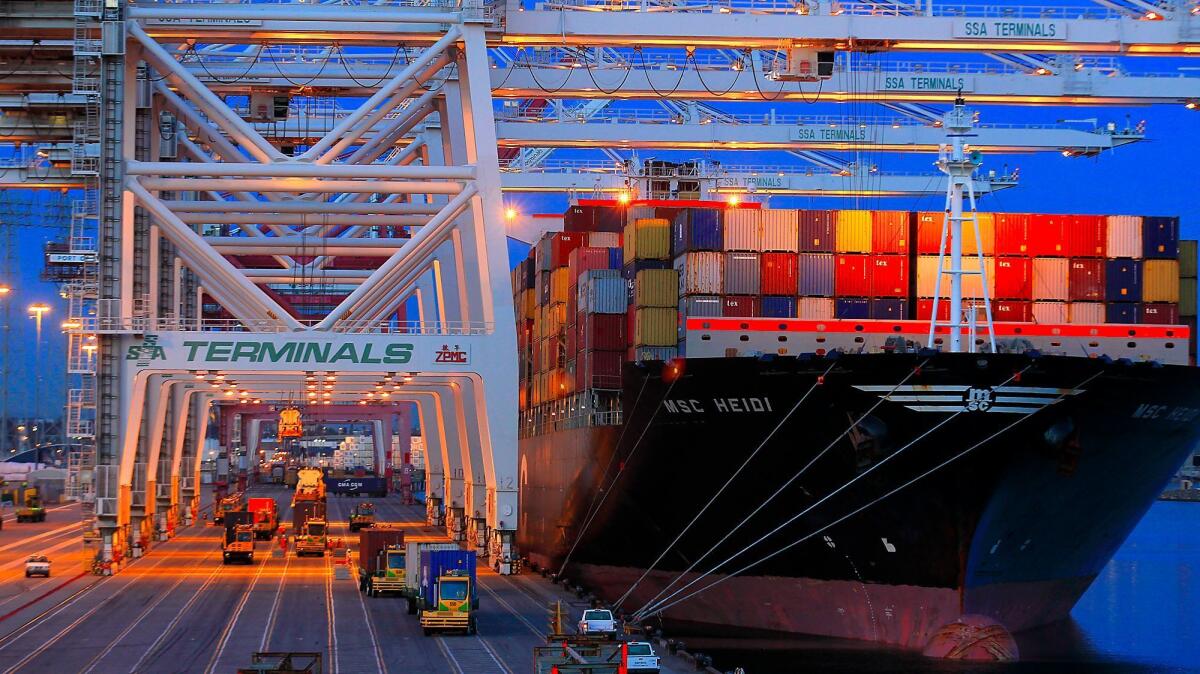Southern California regulators approve smog plan with tougher refinery rules, voluntary measures for ports

- Share via
Southern California air quality officials voted Friday to impose tougher rules on oil refineries but rejected a proposal to regulate pollution from ports and warehouses, which are responsible for much of the region’s harmful emissions.
The South Coast Air Quality Management District’s 15-year smog-reduction plan, approved on an 11-2 vote, will guide efforts to slash emissions as required to meet federal health standards and reduce harm to 17 million people in the nation’s smoggiest region.
But it will rely on only voluntary measures from ports, warehouses and rail yards.
The $16-billion plan is expected to prevent thousands of asthma-related emergency room visits and an estimated 1,600 early deaths a year from air pollution. These benefits, according to an air district analysis, will outweigh the costs to industry, taxpayers and consumers.
But the effort faces immediate obstacles because of its hefty price tag.
Successful implementation would require boosting local, state and federal spending on cash incentives for cleaner vehicles to $1 billion a year — a tenfold increase — at a time when the Trump administration is moving to slash environmental regulations and impose sweeping cuts at the U.S. Environmental Protection Agency.
“This plan relies very, very heavily on a whole bunch of money that we don’t have in our pocket,” said board member Joseph Lyou, who heads the Coalition for Clean Air.
The panel voted 7 to 6 to accelerate existing efforts to reduce smog-forming emissions under AQMD’s troubled pollution-trading program, known as the Regional Clean Air Incentives Market, or RECLAIM. Then, “as soon practicable,” the newly approved plan will replace RECLAIM’s “cap and trade” approach with traditional “command and control” regulations on emissions from specific sources.
The program for nitrogen oxide pollution was established in 1993 to offer flexibility to refineries, power plants and other large facilities.
But state regulators, lawmakers and environmental groups have attacked it for falling short of promised reductions and allowing refineries to avoid installing readily available pollution controls.
Environmentalists applauded regulators’ decision to sunset the cap-and-trade program but accused them of ducking their obligation to clean up the freight industry.
This plan relies very, very heavily on a whole bunch of money that we don’t have in our pocket.
— Joseph Lyou, Coalition for Clean Air
“We can’t get to our clean air goals if the ports and warehouses don’t do their share to reduce emissions,” said Angela Johnson Meszaros, an attorney for Earthjustice. “They let those two major sources skate.”
Under the newly approved plan, the agency will seek cooperation from goods-movement hubs that attract large numbers of trucks, ships and locomotives, asking them to make their own pollution reductions. The air district will pivot to rulemaking mode only if the facilities fail to agree to adequate measures within a year.
Los Angeles City Councilman Joe Buscaino said he expected the ports of Los Angeles and Long Beach to sign an agreement with the air district and “commit to firm dates with emission reduction goals.”
Cargo-moving industries have long opposed local pollution regulations, arguing they will stifle job growth in a sector that supports hundreds of thousands of jobs, while environmentalists have pressed for stricter measures to protect public health.
Tracy Hernandez, chief executive of the Los Angeles County Business Federation, said she was still digesting the late amendments to the plan but remained concerned about their effect. The elimination of the RECLAIM program will be “rough” on oil refiners, she said. “The likely impact is increased cost. And someone’s going to pay for it somehow.”
Also included in the plan was an amendment by board member Clark E. Parker Sr. that will prioritize incentive spending on “the most cost-effective technologies,” such as low-emitting natural gas engines for heavy-duty trucks.
Diesel-fueled big rigs are the region’s top source of nitrogen oxides. Though the Los Angeles-Long Beach port complex has slashed emissions over the last decade, it remains the single largest air pollution source in Southern California, according to the air district.
To meet federal deadlines to reduce ozone, the lung-damaging gas in smog, the region must go beyond existing regulations to slash smog-forming gases called nitrogen oxides 45% by 2023 and an additional 10% by 2031.
The South Coast basin, which spans Los Angeles, Orange, Riverside and San Bernardino counties, has the nation’s highest ozone pollution. Though air quality has improved dramatically over decades, progress has faltered in recent years. The region still does not meet a series of federal health standards going back to 1979.
The plan’s approval follows a heated public hearing last month that drew more than 500 people and hours of testimony. Friday’s hearing had no public comment, but the district’s Diamond Bar hearing room was packed with industry representatives and Sierra Club members, who held a rally outside.
The plan now goes to the California Air Resources Board for consideration and must then be approved by the EPA to become enforceable under the federal Clean Air Act.
In other business Friday, the air board adopted long-delayed regulations on toxic emissions from grinding and cutting operations at 22 metal-forging facilities across the region. The rules, which require such operations occur inside enclosed buildings, came in response to years of community complaints about noxious odors from metal-processing plants in the city of Paramount.
More to Read
Sign up for Essential California
The most important California stories and recommendations in your inbox every morning.
You may occasionally receive promotional content from the Los Angeles Times.














